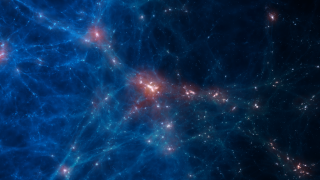Bibcode
Jiang, Fangzhou; Dekel, Avishai; Freundlich, Jonathan; Romanowsky, Aaron J.; Dutton, Aaron A.; Macciò, Andrea V.; Di Cintio, Arianna
Referencia bibliográfica
Monthly Notices of the Royal Astronomical Society, Volume 487, Issue 4, p.5272-5290
Fecha de publicación:
8
2019
Número de citas
149
Número de citas referidas
130
Descripción
We study ultra-diffuse galaxies (UDGs) in zoom in cosmological
simulations, seeking the origin of UDGs in the field versus galaxy
groups. We find that while field UDGs arise from dwarfs in a
characteristic mass range by multiple episodes of supernova feedback (Di
Cintio et al.), group UDGs may also form by tidal puffing up and they
become quiescent by ram-pressure stripping. The field and group UDGs
share similar properties, independent of distance from the group centre.
Their dark-matter haloes have ordinary spin parameters and centrally
dominant dark-matter cores. Their stellar components tend to have a
prolate shape with a Sérsic index n ˜ 1 but no significant
rotation. Ram pressure removes the gas from the group UDGs when they are
at pericentre, quenching star formation in them and making them redder.
This generates a colour/star-formation-rate gradient with distance from
the centre of the dense environment, as observed in clusters. We find
that ˜20 per cent of the field UDGs that fall into a massive halo
survive as satellite UDGs. In addition, normal field dwarfs on highly
eccentric orbits can become UDGs near pericentre due to tidal puffing
up, contributing about half of the group-UDG population. We interpret
our findings using simple toy models, showing that gas stripping is
mostly due to ram pressure rather than tides. We estimate that the
energy deposited by tides in the bound component of a satellite over one
orbit can cause significant puffing up provided that the orbit is
sufficiently eccentric. We caution that while the simulations produce
UDGs that match the observations, they under-produce the more compact
dwarfs in the same mass range, possibly because of the high threshold
for star formation or the strong feedback.
Proyectos relacionados

Astrofísica Numérica: Formación y Evolución de Galaxias
Entre las cuestiones fundamentales en Astronomía y Astrofísica están la formación y evolución de galaxias. Las escalas de tiempo y tamaño son tan astronómicas que su observación en galaxias individuales es imposible. Solo con el uso de simulaciones numéricas es posible entender la formación de estructuras cósmicas dentro del actual marco
Claudio
Dalla Vecchia

Huellas de la Formación de las Galaxias: Poblaciones estelares, Dinámica y Morfología
Bienvenida a la página web del g rupo de investigación Traces of Galaxy Formation. Somos un grupo de investigación amplio, diverso y muy activo cuyo objetivo principal es entender la formación de galaxias en el Universo de una manera lo más completa posible. Con el estudio detellado de las poblaciones estelares como bandera, estamos constantemente
Anna
Ferré Mateu